Related Research Articles

The late romances, often simply called the romances, are a grouping of William Shakespeare's last plays, comprising Pericles, Prince of Tyre; Cymbeline; The Winter's Tale; and The Tempest. The Two Noble Kinsmen, of which Shakespeare was co-author, is sometimes also included in the grouping. The term "romances" was first used for these late works in Edward Dowden's Shakespeare: A Critical Study of His Mind and Art (1875). Later writers have generally been content to adopt Dowden's term.

The earliest texts of William Shakespeare's works were published during the 16th and 17th centuries in quarto or folio format. Folios are large, tall volumes; quartos are smaller, roughly half the size. The publications of the latter are usually abbreviated to Q1, Q2, etc., where the letter stands for "quarto" and the number for the first, second, or third edition published.

Richard III is a play by William Shakespeare. It was probably written c. 1592–1594. It is labelled a history in the First Folio, and is usually considered one, but it is sometimes called a tragedy, as in the quarto edition. Richard III concludes Shakespeare's first tetralogy and depicts the Machiavellian rise to power and subsequent short reign of King Richard III of England.

This article presents a possible chronological listing of the composition of the plays of William Shakespeare.
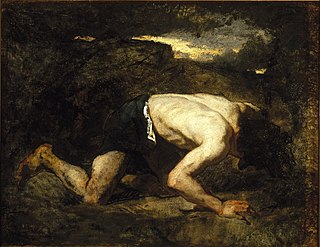
Timon of Athens is a play written by William Shakespeare and probably also Thomas Middleton in about 1606. It was published in the First Folio in 1623. Timon lavishes his wealth on parasitic companions until he is poor and rejected by them. He rejects mankind and goes to live in a cave.

The Shakespeare apocrypha is a group of plays and poems that have sometimes been attributed to William Shakespeare, but whose attribution is questionable for various reasons. The issue is separate from the debate on Shakespearean authorship, which addresses the authorship of the works traditionally attributed to Shakespeare.

Mr. William Shakespeare's Comedies, Histories, & Tragedies is a collection of plays by William Shakespeare, commonly referred to by modern scholars as the First Folio, published in 1623, about seven years after Shakespeare's death. It is considered one of the most influential books ever published.
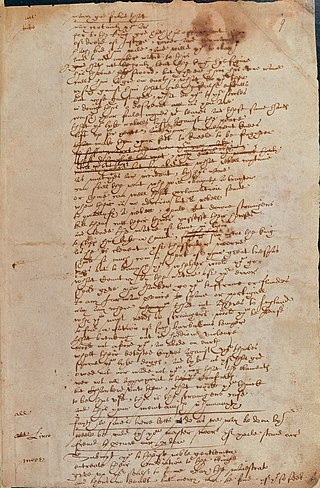
Sir Thomas More is an Elizabethan play and a dramatic biography based on particular events in the life of the Catholic martyr Thomas More, who rose to become the Lord Chancellor of England during the reign of Henry VIII. The play is considered to be written by Anthony Munday and Henry Chettle and revised by several writers. The manuscript is particularly notable for a three-page handwritten revision now widely attributed to William Shakespeare.

Shakespeare's plays are a canon of approximately 39 dramatic works written by English poet, playwright, and actor William Shakespeare. The exact number of plays as well as their classifications as tragedy, history, comedy, or otherwise is a matter of scholarly debate. Shakespeare's plays are widely regarded as being among the greatest in the English language and are continually performed around the world. The plays have been translated into every major living language.
Like most playwrights of his period, William Shakespeare did not always write alone. A number of his surviving plays are collaborative, or were revised by others after their original composition, although the exact number is open to debate. Some of the following attributions, such as The Two Noble Kinsmen, have well-attested contemporary documentation; others, such as Titus Andronicus, are dependent on linguistic analysis by modern scholars; recent work on computer analysis of textual style has given reason to believe that parts of some of the plays ascribed to Shakespeare are actually by other writers.
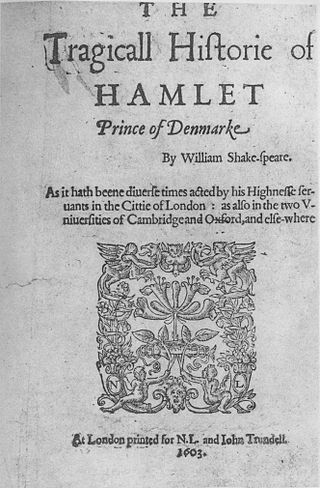
A bad quarto, in Shakespearean scholarship, is a quarto-sized printed edition of one of Shakespeare's plays that is considered to be unauthorised, and is theorised to have been pirated from a theatrical performance without permission by someone in the audience writing it down as it was spoken or, alternatively, written down later from memory by an actor or group of actors in the cast – the latter process has been termed "memorial reconstruction". Since the quarto derives from a performance, hence lacks a direct link to the author's original manuscript, the text would be expected to be "bad", i.e. to contain corruptions, abridgements and paraphrasings.
Shakespeare's editors were essential in the development of the modern practice of producing printed books and the evolution of textual criticism.
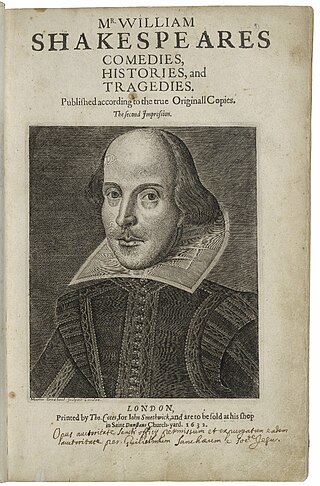
The Second Folio is the 1632 edition of the collected plays of William Shakespeare. It follows the First Folio of 1623. Much language was updated in the Second Folio and there are almost 1,700 changes.
Ralph Crane was a professional scrivener or scribe in early seventeenth-century London. His close connection with some of the First Folio texts of the plays of William Shakespeare has led to his being called "Shakespeare's first editor."

The Riverside Shakespeare is a long-running series of editions of the complete works of William Shakespeare published by the Houghton Mifflin company.

The Plays of William Shakespeare was an 18th-century edition of the dramatic works of William Shakespeare, edited by Samuel Johnson and George Steevens. Johnson announced his intention to edit Shakespeare's plays in his Miscellaneous Observations on Macbeth (1745), and a full Proposal for the edition was published in 1756. The edition was finally published in 1765.

Q1 of Hamlet is a short early text of the Shakespearean play. The intended publication of the play is entered in the Stationers' Register in 1602 by James Roberts, but Q1 was not published until summer or autumn 1603. It was published by the booksellers Nicholas Ling and John Trundell, and printed by Valentine Simmes. Roberts later printed the "Second Quarto" (Q2).

Shakespeare attribution studies is the scholarly attempt to determine the authorial boundaries of the William Shakespeare canon, the extent of his possible collaborative works, and the identity of his collaborators. The studies, which began in the late 17th century, are based on the axiom that every writer has a unique, measurable style that can be discriminated from that of other writers using techniques of textual criticism originally developed for biblical and classical studies. The studies include the assessment of different types of evidence, generally classified as internal, external, and stylistic, of which all are further categorised as traditional and non-traditional.

The Dering Manuscript is the earliest extant manuscript text of any play by William Shakespeare. The manuscript combines Part 1 and Part 2 of Henry IV into a single-play redaction. Scholarly consensus indicates that the manuscript was revised in the early 17th century by Sir Edward Dering, a man known for his interest in literature and theater. Dering prepared his redaction for an amateur performance starring friends and family at Surrenden Manor in Pluckley, Kent, where the manuscript was discovered in 1844. This is the earliest known instance of an amateur production of Shakespeare in England. Sourced from the 1613 fifth quarto of Part 1 and the 1600 first quarto of Part 2, the Dering Manuscript contains many textual differences from published quarto and folio editions of the plays. Dering cut nearly 3,000 lines of Shakespearean text and added some 50 lines of his own invention along with numerous minor interventions. The Dering Manuscript is currently a part of the collection at the Folger Shakespeare Library in Washington, DC.
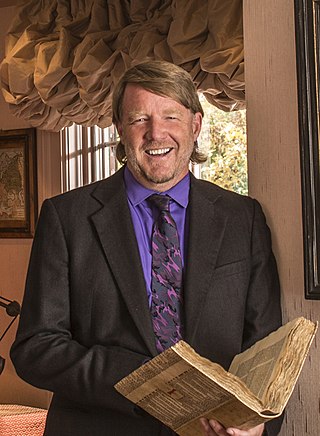
Eric Rasmussen is an American scholar, academic and author. He is Regents Teaching Professor and Foundation Professor of English at the University of Nevada.
References
- Evans, G. Blakemore, textual editor. The Riverside Shakespeare. Boston, Houghton Mifflin, 1974.
- Harlow, C. G. "Shakespeare, Nashe, and the Ostridge Crux in 1 Henry IV." Shakespeare Quarterly Vol. 17, No. 2 (Spring 1966), pp. 171–4.
- Newcomer, Alphonso Gerald. "A Shakespeare Crux." Modern Philology, Vol. 11, No. 1 (July 1913), pp. 141–4.